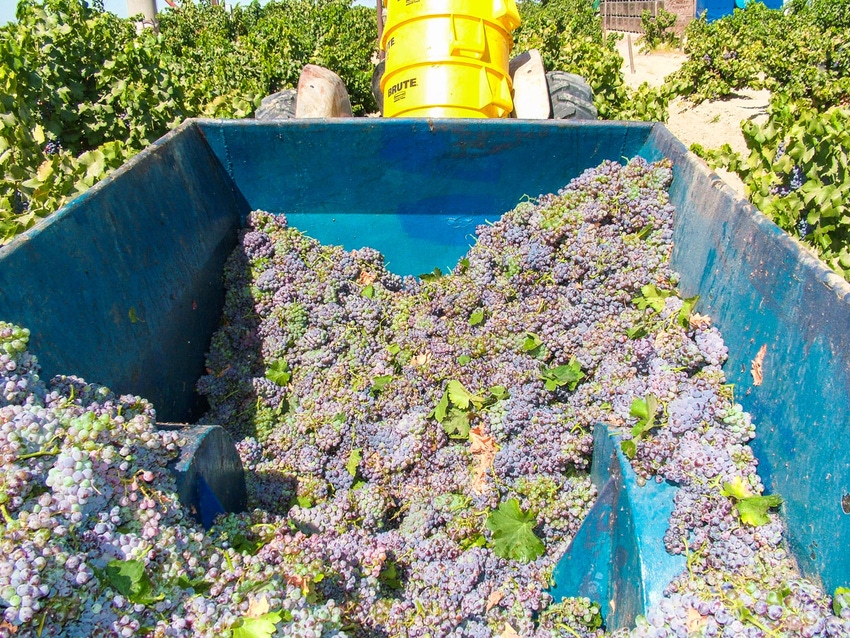
By the first of September, six weeks after he and crews began harvesting wine grapes in the central and southern San Joaquin Valley, yields had been ranging from low to average, reports Luke Shoffner.
Based in Selma, Calif., his company, R.L Shoffner Harvesting Inc., provides custom harvesting for growers in a roughly 130-mile long swath from Kern County north through Kings, Tulare and Fresno counties to Madera County.

Luke Shoffner says grape growers are looking for more labor-saving services.
Shoffner grows 30 acres of his own wine grapes and fields 13 grape harvesting machines, along with 60 operators and four mechanics, to pick a total of about 6,500 acres of grapes.
This year they began the season in a Fresno County Zinfandel vineyard on July 21st. Shoffner expects to complete harvest by the end of October. Typically, the last fruit to be picked is Cabernet Sauvignon or Rubired, in either Fresno or Kings County.
“Our season started out at a fast pace with a lot of blocks ready to pick all around the same time,” Shoffner says. “Then, it was a roller coaster of faster and slower periods until the end of August. From here on out we hope to be harvesting at a steady pace.”
He harvested the first crop from his 10 acres of Pinot Gris vines, which he planted three years ago, at the end of July. Shoffner harvested his 20 acres of Zinfandel grapes in the first week of August.
Unlike his large Zinfandel crop last year, yields from those vines this year were average, he reports. “The quality of both varieties of grapes was good. The Zinfandel clusters formed nicely and sized well, but the cluster counts of the Zinfandel were lower than last year.”
In early August, his crews were starting to harvest more Zinfandel in various areas of the San Joaquin Valley, along with Chardonnay and Pinot Gris, before advancing a little later into French Colombard and Muscat grapes. Midway through the month Pinot Gris was completed and by early September all the Zinfandel and Chardonnay were finished as well.
The slowdowns during the first month and a half of the harvest reflected periods of 100-plus-degree weather, which affected the ripening process and overall fruit quality in many varieties.
“Normally, we pick for about a 12-hour shift, starting around 7 in the evening,” he says. “But, when temperatures reach into triple digits, we’ll wait until 9 or 10 at night to begin harvesting and work a little later than usual in the morning while the temperature is still cool.”
Although the healthy conditions of the vineyards he’s been harvesting this year reflect the ample amount of surface and ground water they’ve received, the grapes have been showing the effects of the frequent spells of summer’s unusually hot weather.
“Several weeks of heat in July weakened the berries, breaking down the fruit in some cases as sugar levels rose,” says Shoffner, who’s been custom harvesting for 20 years. “I’ve never seen heat damage as widespread as it’s been this year. Normally, we might see it in a vineyard here and there. But, this year, many vineyards have had a problem of fruit suffering from the high temperatures.”
He and his crews have also been finding more rot than usual in a few cases. As a result, some growers have had to drop fruit in about 200 acres of vines to meet winery requirements, Shoffner reports. Last year none of his growers dropped any grapes due to rot.
Earlier in the harvest some vineyards were suffering from high powdery mildew pressure, Shoffner adds.
Shoffner grew up in a grape-growing family. His father, Randy, who started growing grapes in the 1960s, provided crews for hand-harvesting grapes for about 30 years, until switching to custom machine harvesting in the late 1990s.
Today Luke Shoffner’s crews operate grape harvesters, made by Upright and American Grape Harvesters, capable of harvesting up to 42-inch cross arms. The crews and their machines harvest an average of about 12 acres per night per harvester.
Keeping that equipment up and running is the job of Shoffner’s four-man service and maintenance crew. Depending on the pace of harvest, one or two of the mechanics head out daily at daybreak to begin washing and servicing the harvesting machines and making minor repairs. Luke and the rest of the crew handle any major repair needs.
“To minimize downtime during harvest, we try to take care of all maintenance problems in the off-season so that when harvesting begins, all of our equipment is in top condition and operating properly,” Shoffner says. “Because our operations are so widespread, our maintenance guys do a lot of driving to ensure the harvesters are well maintained during harvest”.
Over the past year Shoffner has been evaluating several different lines of mechanical pruning equipment. He is looking to mount mechanical pruners onto his existing harvesters as well as on tractors. He plans to purchase a few units later this year or next year.
“A lot of my growers are interested in this service,” Shoffner says. “They’re looking for ways to reduce labor costs to stay competitive, especially due to the state’s new minimum wage rate for farm workers. Eventually, I may add machines for mechanizing sucker removal in the vineyard as well.”
About the Author(s)
You May Also Like




